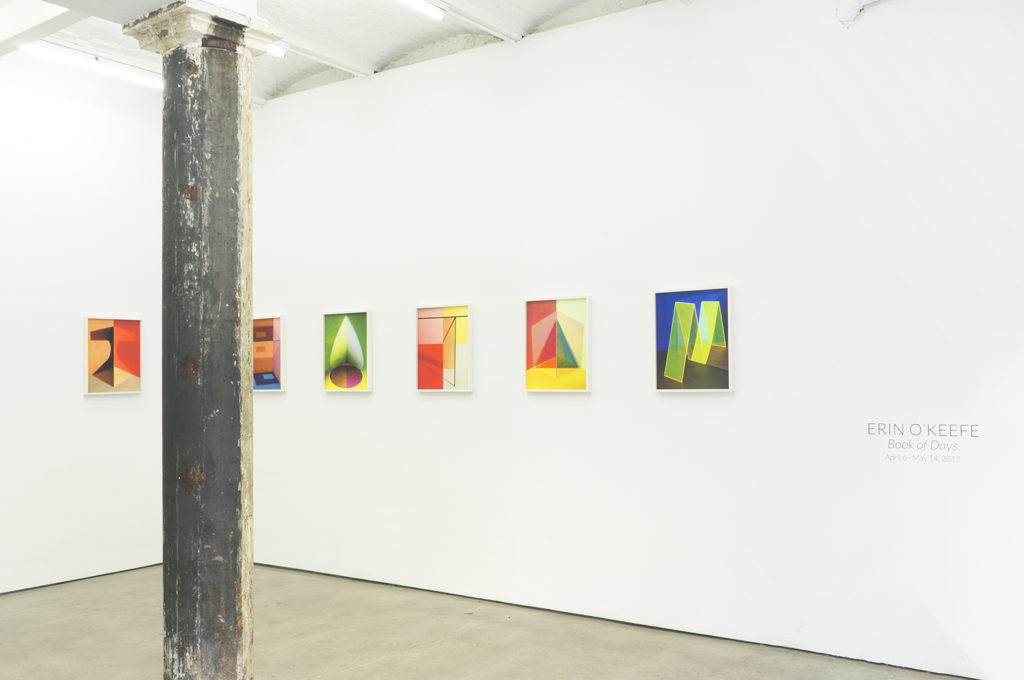Erin O’Keefe, Book of Days @Denny
By Loring Knoblauch, May 1, 2017
JTF (just the facts): A total of 15 color and black and white photographs, framed in white and unmatted, and hung against white walls in the two room gallery space. All of the works are archival pigment prints mounted on museum board, made in 2016 and 2017. Physical sizes are either 20×16, 25×20, or 40×32, and all of the prints are available in editions of 3.

Comments/Context: While we often like to celebrate the blast of serendipitous genius found in artistic insight, for most artists and photographers, the process of finding a worthy path to follow is much less glamorous. Absent the arrival of an obvious lightning strike, they get to work investigating a set of not-yet-fully-formed ideas, and through a patient dose of methodical effort, slowly figure out which of these potential aesthetic or conceptual discoveries actually has merit.
When I reviewed Erin O’Keefe’s 2015 show at Denny Gallery (here), it was clear that she was in the middle of just such a process of open-ended exploration. In her Things As They Are series, her table top setups began with a limited set of constraints (a three sided painted corner, a selection of tinted Plexiglas sheets, and a few painted sticks), which she then iteratively combined using cast light as her activating agent. And her initial results gave her some promising clues – depending on the choices she made with the painted backdrop and edge-on (and therefore effectively invisible) tinted sheet, the light could create a multitude of additive color geometries, with overlaps and shadows creating sharp angles and unexpected shapes.
Two years later, O’Keefe has now reached #53 in this series, and her results are much more compositionally complex and nuanced. The transparent sheets have evolved from simple rectangles and squares (previously always in the same physical location in the setup) into circles, triangles, and bolder curved polygons that wander into new places, paired sheets that create reflections, and even one sheet with a central cutout that generates a rectangle-within-a-rectangle form. The thin sticks are now generally used in pairs, and a few move on from strictly matched geometries to unbalanced linear forms. And when all these new approaches are intermingled, what emerges are abstractions that are increasingly sophisticated – colors pile up in angled slices, shadows are cast in inexplicable directions, and formal equilibrium is much more precarious. Overall, the best of the images are less easily read than her first forays, making us work a little harder to unpack them.
In O’Keefe’s new Book of Days works, the artist moves in an adjacent direction, continuing to rely on the flattening effect of the camera’s vision, but moving on from controlled experiments with light and shadow to more emphasis on three dimensional construction. Painted cardboard cutouts are built into dense made-to-be-photographed sculptures with see-through depth and contrasts of flat and curved edges, the planes of fragmented color becoming sinuously tangled when collapsed into a single composition. The effect is something akin to late scissor-ready Henri Matisse and frenetic jazz-age Stuart Davis thrown into a Cubist blender and then mediated by a camera.
Once this framework was in place, O’Keefe then began to experiment with different tonal combinations, trying bright primary colors and softer pastels, grey and black backdrops (creating alternate spatial depths), and even a few monochrome white/grey/black compositions that feel more restful and nuanced than the brash shifting vibrancy found in the color works. This painterly new series feels like it has plenty of forward running room, most notably in its ability to use intricate sculptural construction to explore larger scale.
What distinguishes O’Keefe’s work is her unusual approach to interrogating abstraction. In her world, built physicality is the underlying driver that generates her formal outcomes, and her camera provides the downstream mechanism for the translations. This 3D to 2D jujitsu, and its inherent visual reconfigurations, isn’t entirely new in and of itself, but it is providing O’Keefe with novel ways to reintroduce uncertainty into abstraction. While painters and graphic designers of bygone eras may have pioneered some of the motifs O’Keefe is now recycling, she is thoroughly making them her own, and giving them contemporary freshness, by reconstructing them using these hybrid sculptural/photographic methods. Her newest works are a strong step forward, and confident evidence that her artistic momentum is starting to gather.
Collector’s POV: The works in this show are priced at $3200, $4150, and $6200, based on size, with prices rising as the editions sell. O’Keefe’s work has little secondary market history at this point, so gallery retail remains the best option for those collectors interested in following up.
